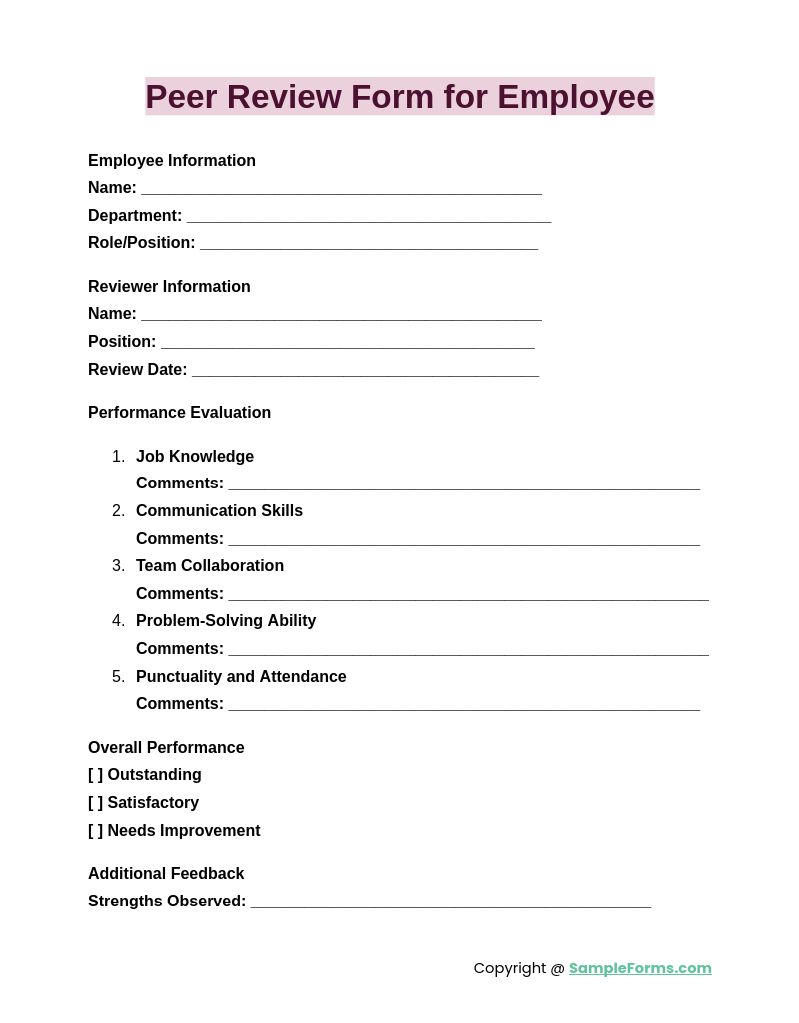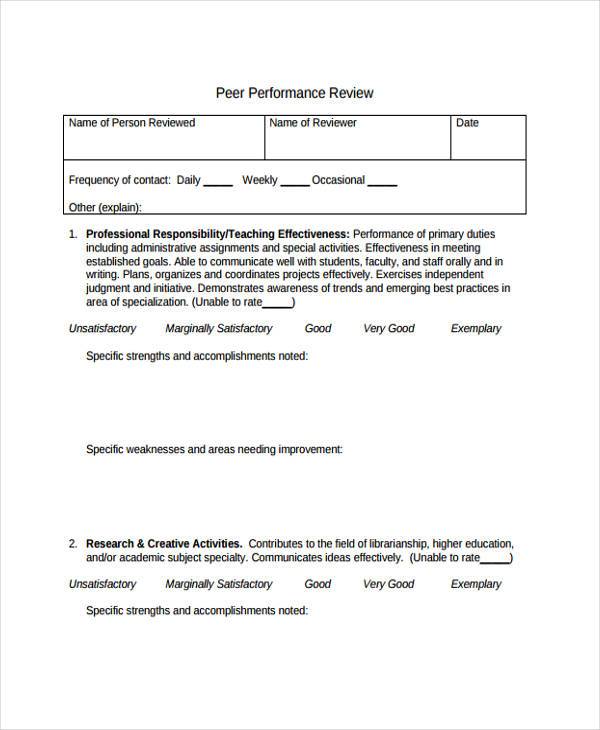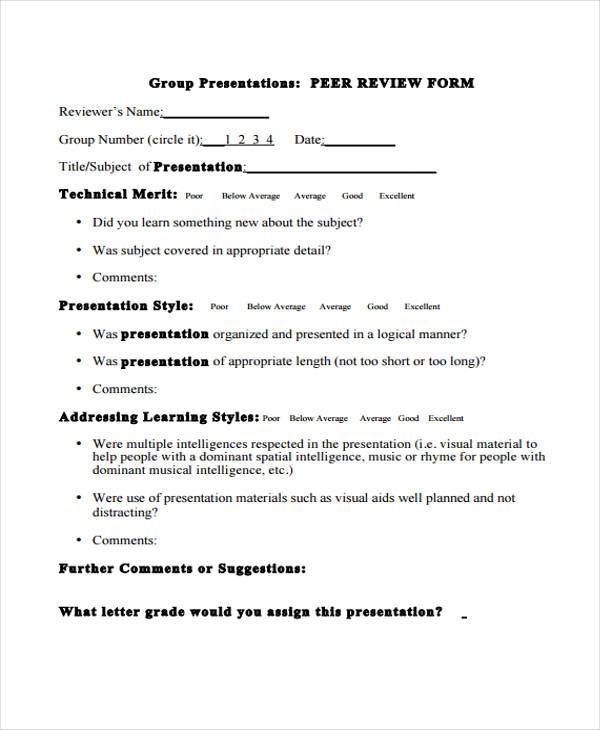A Peer Review Form is essential for providing structured feedback, improving collaboration, and ensuring fair evaluations in various environments. Whether it’s for academic projects, workplace assessments, or group activities, a well-designed Review Form ensures clarity and actionable feedback. This guide explores how to create effective forms, leveraging tools like a Peer Evaluation Form for structured and unbiased reviews. With examples and best practices, learn to design forms that foster improvement and maintain professionalism in any setting.

Download Peer Review Form Bundle
What is Peer Review Form?
A Peer Review Form is a tool used for collecting structured feedback from peers regarding performance, contributions, or quality of work. It facilitates transparent evaluations in academic, professional, or collaborative environments. Designed for fairness, it ensures clear communication and actionable insights.
Peer Review Format
Reviewer Information
Name: _________________________________
Position: _______________________________
Review Date: ___________________________
Review Details
Name of Person Reviewed: ___________________________
Project/Task: ______________________________________
Review Period: ____________________________________
Evaluation Criteria
Strengths Observed: ___________________________________
Areas for Improvement: ________________________________
Suggestions/Recommendations: __________________________
Reviewer Acknowledgment
Signature: __________________________ Date: ___________
Peer Review Form for Students

The Peer Review Form for Students encourages collaborative learning and critical thinking. It allows students to evaluate peers’ contributions and improve their skills through constructive feedback, aligning with the purpose of a Peer Observation Form.
Peer Review Form for Research Paper

A Peer Review Form for Research Paper ensures the credibility and quality of academic work. It evaluates research for clarity, originality, and methodology, using a structure similar to a Peer Assessment Form.
Peer Review Form for Group Project

The Peer Review Form for Group Project enhances team dynamics by assessing individual contributions. It helps identify strengths and areas for improvement, offering feedback akin to a Peer Feedback Form for team performance.
Peer Review Form for Employee

The Peer Review Form for Employee improves workplace productivity by assessing skills and teamwork. It aids in performance evaluations, complementing a structured Probation Review Form for employee development and progression.
Browse More Peer Review Forms
Medical Peer Review Form
Peer Review Reporting Form
Peer Review Feedback Form
Peer Review Form in PDF
Employee Peer Review Form
Peer Performance Review Form
Peer Review Form Example
Peer Presentation Review Form
Sample Peer Review Feedback Form
Peer Review Form in Doc
General Peer Review Input Form
How do you write a peer review document?
A peer review document should provide constructive feedback on performance, quality, or contributions. It ensures transparency and improvement. Key rules include:
- Identify Review Objectives: Clearly state the purpose of the review, such as assessing an Internship Review Form or other performance criteria.
- Structure the Document: Use sections for strengths, weaknesses, and actionable feedback for better clarity.
- Use Objective Language: Provide unbiased and professional observations.
- Include Examples: Support feedback with specific examples to improve understanding.
- Conclude with Suggestions: End with practical recommendations for improvement and growth.
What is the purpose of peer review?
The purpose of peer review is to evaluate contributions, enhance quality, and foster accountability. It promotes growth through constructive feedback. Key points include:
- Ensure Quality Standards: Maintain high standards, akin to evaluating a Restaurant Review Form for service quality.
- Encourage Collaboration: Promote teamwork and mutual understanding.
- Identify Strengths and Weaknesses: Highlight areas of excellence and improvement.
- Support Decision-Making: Provide insights for managerial decisions or assessments.
- Build Accountability: Ensure transparency in group or individual performance.
What are the 8 peer review tips?

Effective peer reviews depend on structured feedback and clear communication. These tips ensure valuable evaluations:
- Be Objective: Focus on performance metrics, as in an Employee Review Form, avoiding personal bias.
- Provide Specific Feedback: Mention exact actions or outcomes for better clarity.
- Use Positive Language: Frame suggestions constructively to motivate improvement.
- Stay Professional: Maintain a formal and respectful tone throughout.
- Focus on Actionable Items: Highlight changes that can lead to immediate improvement.
- Include Examples: Use scenarios or examples for clarity.
- Balance Praise and Critique: Ensure feedback covers both strengths and areas for development.
- Set Follow-Up Actions: Encourage continuous improvement by providing next steps.
What are the disadvantages of peer review?
Peer reviews, while beneficial, may present challenges that impact their effectiveness. Understanding these pitfalls is crucial for improvement. Key issues include:
- Potential Bias: Personal opinions may skew results, similar to issues in a Salary Review Form.
- Inconsistent Standards: Varying criteria among reviewers can lead to discrepancies.
- Time Consumption: Reviews may require significant time, delaying outcomes.
- Lack of Expertise: Reviewers may lack knowledge to provide valuable feedback.
- Negative Impacts on Relationships: Honest feedback might strain interpersonal dynamics.
How to fill a peer review form?
Filling a peer review form requires clear, structured, and unbiased input to ensure effective feedback. Follow these steps:
- Understand Form Objectives: Know the purpose, whether it’s an Employee Performance Review Form or another evaluation.
- Provide Honest Feedback: Ensure responses are transparent and fair.
- Use Metrics: Reference specific performance indicators or standards.
- Highlight Strengths and Weaknesses: Clearly outline areas of excellence and development.
- Conclude with Suggestions: Offer actionable recommendations for growth and improvement.
Can anyone do a peer review?
Not everyone can conduct peer reviews; only those with expertise and relevant knowledge can provide accurate evaluations, similar to a Training Review Form process.
What not to do in a peer review?
Avoid personal biases, vague feedback, and disrespectful language during reviews. Maintain professionalism akin to conducting a Monthly Review Form.
Can anyone be a peer reviewer?
A peer reviewer must have domain expertise and a clear understanding of evaluation standards, similar to preparing a Policy Review Form.
Who performs peer review?
Experts or peers with relevant qualifications and experience conduct reviews, ensuring credibility, much like a Risk Assessment Review Form process.
Can peer review be wrong?
Yes, inaccuracies can occur due to bias, insufficient knowledge, or unclear standards, reflecting challenges similar to a Manager Job Application Review Form.
What is the golden rule of peer review?
The golden rule is to provide constructive, unbiased feedback that encourages improvement, akin to conducting a Recruiter Performance Review Form.
What not to say during a review?
Avoid making derogatory comments or unsupported claims. Focus on facts and actionable feedback, similar to a Loan Application Review Form process.
What not to do in a peer review?
Avoid rushing through evaluations, neglecting evidence, or being overly critical without basis, as seen in ineffective Contract Review Form reviews.
Who is eligible for peer review?
Individuals with expertise and relevant qualifications in the subject matter are eligible, akin to roles in Project Review Form assessments.
What qualifies as peer reviewed?
Work reviewed and validated by experts within the same field qualifies as peer-reviewed, ensuring credibility, much like a Financial Review Form verification.
Using a Peer Review Form fosters fair evaluations and enhances team dynamics. Whether assessing group projects or individual contributions, tools like the Grant Review Form simplify feedback collection. Explore tailored samples to improve performance and collaboration.
Related Posts
-
Document Review Form
-
Internship Review Form
-
FREE 10+ Work Review Forms in PDF | MS Word
-
FREE 13+ Self Review Forms in PDF | MS Word
-
FREE 10+ Employee Self-Reviews Forms in PDF | MS Word
-
FREE 14+ Review Forms for Staff in PDF | MS Word
-
Employee Performance Review [ Questions ]
-
Employee Performance Review Questions
-
FREE 9+ Financial Review Forms in PDF | Ms Word
-
What Is a Candidate Review Form? [ Definition, How it Works ]
-
FREE 7+ Contract Review Forms in PDF | Ms Word
-
FREE 7+ Training Review Forms in PDF | MS Word
-
FREE 6+ Monthly Review Forms in MS Word | PDF
-
FREE 7+ Annual Review Forms in PDF
-
FREE 8+ Project Review Forms in PDF | Ms Word












